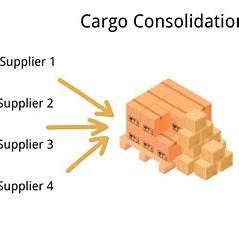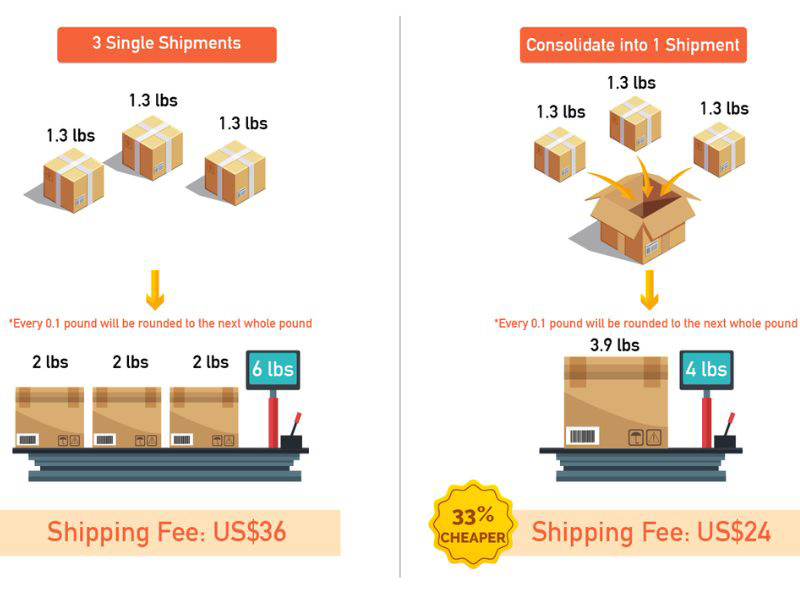Is Consolidated Shipping from China Cheaper? A Complete Cost Breakdown
Introduction
If you’re importing goods from China into Europe or North America, finding the most cost-effective shipping strategy is key. Whether you’re ordering from multiple suppliers or managing regular restocks, consolidated shipping—grouping smaller orders into one shipment—is often the smarter choice. This guide examines:
- Definitions and methods: parcel, LCL, FCL, and air
- Cost comparisons with real data
- Hidden fees and dimensions charges
- Trade policy shifts in 2025 impacting shipping economics
- Strategies to decide when consolidation delivers the best value

1. What Is Consolidated Shipping?
Consolidated (or groupage) shipping refers to pooling multiple smaller shipments at a freight forwarder’s warehouse in China and sending them together via LCL (sea), consolidated airfreight, or FCL. This avoids paying multiple minimum charges and streamlines customs and documentation.Freightos+5Fulfillment-Box+5IncoDocs+5森林运输+1
This method bridges the gap between full-container load shipping (FCL) and individual parcels, offering cost efficiency for small to mid-size importers.
2. Comparing Shipping Methods and Typical Costs
2.1 Parcel Shipping
- Courier or express services are about $5/kg for shipments up to ~150 kg.DIDADIFreightos
- Subject to dimensional weight rules—less dense packages are often charged by volume, not actual weight.Just China It+14维基百科+14C.H. Robinson+14
- Best for small, urgent shipments—but less cost-effective in 2025 due to tariff changes.
2.2 Standard Air Freight
- Cheaper than parcels at around $3/kg for moderate volumes (150–500 kg).森林运输Freightos
- Still sensitive to dimensional weight.
2.3 Consolidated Air Freight
- Offers 30–50% savings over standard air bookings by pooling cargo.Just China It+3维基百科+3Freightos+3森林运输+3Dantful物流+3汉航国际物流+3
- Ideal for medium‑size, time-sensitive shipments.
2.4 Sea Freight LCL (Consolidated)
- Rates vary typically between $50–100 per CBM to Europe.Just China It+4Fulfillment-Box+4森林运输+4
- FCL becomes most economical once you bulk up to ~8–13 CBM: a 20-foot container costs about $1,500–4,000 USD in 2025.Dantful物流+3森林运输+3Dantful物流+3
3. 2025 Trade Shifts: How Tariffs Changed the Game
- The U.S. de minimis threshold for small parcels (<$800) was repealed in May 2025, meaning all parcels are now subject to customs fees and duties.Easyship
- Spot air rates spiked by ~37% as shipments accelerated before tariff changes.中远物流+14Easyship+14Reddit+14
- Now, consolidated shipping offers a buffer: fewer websites to clear, unified billing, and better duty planning.
4. Real Cost Comparison Scenarios
Scenario A: Two small parcels
- Parcel A: 0.14 m³; Parcel B: 0.20 m³ → individually billed at 0.3 m³ each = 0.6 m³ total.
- With consolidation: billed for combined 0.34 m³ only—saving nearly 77%.DIDADI+7Buy&Ship Australia+7IncoDocs+7GIMworld
Scenario B: 200 kg air shipment
- Standard air: ~$600
- Consolidated air: ~$380–430 → ≈30–35% savings depending on volumetric weight.
Scenario C: Quarterly 500 kg bulk
- Parcel shipping: ~$2,500
- Consolidated air: ~$1,500
- Or LCL sea: ~$200–300 total CBM cost → deeper savings for higher volumes.
5. Beyond Base Rates: Additional Cost Factors
- Dimensional Weight Charges: Penalizes bulky shipments in courier and air freight models.Fulfillment-Box+2Reddit+2Servotech Shipping+5Reddit+5森林运输+5维基百科
- Handling and Documentation Fees (CA and CIF): LCL often incurs terminal handling fees. Consolidated shipments centralize documentation into one bill.IncoDocs
- Customs and Duties: Parcels now all require duties under the new U.S. rules.
- Storage Fees and Rehandling: Multiple parcel arrivals can incur warehouse charges; consolidation avoids repetition.GIMworldIncoDocs
6. When Consolidation Is Cheaper—and When Parcel Shipping Still Works
✅ Consolidation is better when:
- You have multiple items from different suppliers or orders
- Shipments total >10 kg or smaller but low-density items
- You can wait ~10 days for consolidated air freight or ~30–40 days for LCL
- 2025 tariff policies mean duty savings across volumes
🚚 Parcel shipping still makes sense when:
- You need urgent delivery within 3–7 days
- The package is small, dense, and minimises dimensional weight issues
- Costs of customs entries are relatively minor compared to delivery speed benefit
- You’re shipping fewer than ~150 kg and need flexibility
7. Tips to Maximize Savings with Consolidation
- Group multiple orders into one warehouse booking
- Request full landed-cost quotes—including duties, insurance, documentation, delivery
- Optimize packing to minimize volume and avoid DIM weight charges
- Compare rates between air consolidation and sea LCL based on urgency
- Track tariff trends and seasonal rate spikes, especially mid‑Q3 peaks in demand.GIMworldFreightosJust China ItEasyshipC.H. RobinsonIncoDocs
8. Quotes & Community Insights
“Regardless—consolidation is generally cheaper for multiple items…” (on Reddit, user comment)Reddit
“Sea freight: $450 for 500 units vs. air freight $2,250” — real-world Reddit rate comparison highlights sea savings.Reddit+1
9. Summary Table: At a Glance
| Shipment Scenario | Parcel Cost | Consolidated Cost | Relative Savings |
|---|---|---|---|
| Two small parcels (~0.34 m³) | Charged for 0.6 m³ | Charged for 0.34 m³ | ~40–50% |
| 150 kg urgent | ~$750 (parcel) | ~$450 (consolidated air) | ~40% savings |
| 500 kg mixed volume | ~$5,000 (parcel) | ~$300 (sea LCL) or ~$1,500 (air) | >70% (sea) |

Conclusion
Consolidated shipping from China is generally a more cost-effective and strategic method for European and North American importers—particularly after 2025 customs policy updates. While parcel shipping still has niche use cases for urgency and small dense parcels, consolidation offers:
- Substantial cost savings per unit
- Simplified customs, documentation, and tracking
- Flexibility to scale between air, sea, and FCL
- Lower complexity and better predictability
For regular importers or multi-supplier ventures, consolidation is not just cheaper—it’s smarter logistics.

